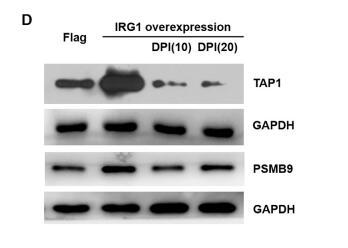Proteasome 20S LMP2 Antibody - #DF6606
| Product: | Proteasome 20S LMP2 Antibody |
| Catalog: | DF6606 |
| Description: | Rabbit polyclonal antibody to Proteasome 20S LMP2 |
| Application: | WB IHC |
| Cited expt.: | WB |
| Reactivity: | Human, Mouse, Rat |
| Prediction: | Pig, Bovine, Horse, Sheep, Rabbit, Dog, Xenopus |
| Mol.Wt.: | 23kDa; 23kD(Calculated). |
| Uniprot: | P28065 |
| RRID: | AB_2838568 |
Related Downloads
Protocols
Product Info
*The optimal dilutions should be determined by the end user. For optimal experimental results, antibody reuse is not recommended.
*Tips:
WB: For western blot detection of denatured protein samples. IHC: For immunohistochemical detection of paraffin sections (IHC-p) or frozen sections (IHC-f) of tissue samples. IF/ICC: For immunofluorescence detection of cell samples. ELISA(peptide): For ELISA detection of antigenic peptide.
Cite Format: Affinity Biosciences Cat# DF6606, RRID:AB_2838568.
Fold/Unfold
Beta1i; Large multifunctional peptidase 2; Large multifunctional protease 2; LMP 2; LMP2; Low molecular mass protein 2; Macropain chain 7; MGC70470; Multicatalytic endopeptidase complex chain 7; OTTHUMP00000062982; Proteasome (prosome macropain) subunit beta type 9; proteasome (prosome, macropain) subunit, beta type, 9 (large multifunctional peptidase 2); Proteasome beta 9 subunit; Proteasome catalytic subunit 1i; Proteasome chain 7; Proteasome related gene 2; Proteasome subunit beta 6i; Proteasome subunit beta type 9; Proteasome subunit beta type-9; Proteasome subunit beta-1i; PSB9_HUMAN; PSMB 9; PSMB6i; PSMB9; Really interesting new gene 12 protein; RING 12; RING12; RING12 protein;
Immunogens
A synthesized peptide derived from human Proteasome 20S LMP2, corresponding to a region within the internal amino acids.
- P28065 PSB9_HUMAN:
- Protein BLAST With
- NCBI/
- ExPASy/
- Uniprot
MLRAGAPTGDLPRAGEVHTGTTIMAVEFDGGVVMGSDSRVSAGEAVVNRVFDKLSPLHERIYCALSGSAADAQAVADMAAYQLELHGIELEEPPLVLAAANVVRNISYKYREDLSAHLMVAGWDQREGGQVYGTLGGMLTRQPFAIGGSGSTFIYGYVDAAYKPGMSPEECRRFTTDAIALAMSRDGSSGGVIYLVTITAAGVDHRVILGNELPKFYDE
Predictions
Score>80(red) has high confidence and is suggested to be used for WB detection. *The prediction model is mainly based on the alignment of immunogen sequences, the results are for reference only, not as the basis of quality assurance.
High(score>80) Medium(80>score>50) Low(score<50) No confidence
Research Backgrounds
The proteasome is a multicatalytic proteinase complex which is characterized by its ability to cleave peptides with Arg, Phe, Tyr, Leu, and Glu adjacent to the leaving group at neutral or slightly basic pH. The proteasome has an ATP-dependent proteolytic activity. This subunit is involved in antigen processing to generate class I binding peptides. Replacement of PSMB6 by PSMB9 increases the capacity of the immunoproteasome to cleave model peptides after hydrophobic and basic residues.
Autocleaved. The resulting N-terminal Thr residue of the mature subunit is responsible for the nucleophile proteolytic activity.
Cytoplasm. Nucleus.
Belongs to the peptidase T1B family.
Research Fields
· Genetic Information Processing > Folding, sorting and degradation > Proteasome.
References
Application: WB Species: human Sample:
Restrictive clause
Affinity Biosciences tests all products strictly. Citations are provided as a resource for additional applications that have not been validated by Affinity Biosciences. Please choose the appropriate format for each application and consult Materials and Methods sections for additional details about the use of any product in these publications.
For Research Use Only.
Not for use in diagnostic or therapeutic procedures. Not for resale. Not for distribution without written consent. Affinity Biosciences will not be held responsible for patent infringement or other violations that may occur with the use of our products. Affinity Biosciences, Affinity Biosciences Logo and all other trademarks are the property of Affinity Biosciences LTD.


